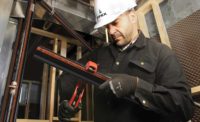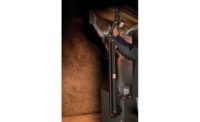Gas-fired appliances are commonly used for space heating, water heating, cooking and more. Such appliances provide comfort and convenience that improve the quality of life. While it is easy to appreciate the benefits of gas appliances, venting of such appliances can, at times, be an afterthought.
However, proper ventilation of gas appliances is essential for safety and efficiency, and a critical part of preventing harmful exposure to carbon monoxide and fire hazards. To ensure gas-fired appliances are vented properly, jurisdictions throughout the United States turn to the Uniform Me-chanical Code (UMC) for the proper requirements. Unlike other model codes, the UMC incorporates the fuel-gas provisions so there is no need to consult two separate documents. The UMC provides all the necessary venting provisions in Chapter 8, which correlates with the National Fuel Gas Code (NFPA 54).
General requirements: Section 802.3 (Design and Construction) of the 2018 UMC explains that a venting system is designed so that it conveys the combustion fumes, which are the byproduct of burning gas, to the outdoors. Other important parameters in designing gas appliance venting systems include preventing damage to the appliance due to flue gas condensation, preventing excessive heat from affecting nearby materials and minimizing leakage of combustion products into the indoor space.
Chapter 8, which covers chimneys and vents, provides the proper guidelines for the venting of low-heat and medium-heat gas appliances. While most gas appliances require venting, a list of appliances that are not required to be vented is detailed in Section 802.2.1 (Appliances Not Required to be Vented). The list includes listed ranges and refrigerators, instantaneous water heaters used with a dishwasher, counter appliances and unvented room heaters.
Since venting requirements for gas appliances such as furnaces, boilers and water heaters vary depending on the type of appliance, one of the first steps to ensuring proper venting of such appliances is to determine which code requirements are applicable for the specific installation. Table 802.4 of the UMC separates gas appliances into vented appliance categories. These categories are used to help determine the type of venting system that should be used for the appliance. For example, according to Table 802.4, Category I appliances require a Type B gas vent, chimney, single-wall metal pipe or a special gas vent; while listed vented wall furnaces require a Type B-W gas vent. Type B gas vents are designed for appliances that burn gas only and Type B-W vents are used for gas-fired wall furnaces.
It is common for gas water heaters and gas furnaces to be of the atmospheric combustion type. On these typical gas appliances, the gas fuel is burned and the heat created from the combustion process provides the heat needed for the appliance to operate. The combustion fumes must be transferred to the outdoors by the vent system. Atmospheric venting relies heavily on thermal stratification of air, which is a result of hot air rising naturally because it is less dense than the surrounding air. For this reason, the most effective vent piping configurations are installed as vertically as possible. Besides naturally venting combustion byproducts to the outdoors, Section 802.3.3 (Mechanical Draft Systems) also allows fan-assisted mechanical draft systems to be used, which can be of either a forced or induced draft design. Such systems are further addressed in Section 802.3.3.1 through 802.3.3.5.
Vent offsets and acceptable slopes: One of the most common installation defects with venting gas appliances is an improperly sloped vent connector. Preferably, the vent system would be installed completely vertically; however, since this is not always feasible, the UMC provides guide-lines for installing vent offsets and the acceptable slope of the vent connector. Where used, vent offsets are typically installed between the vent and the draft hood of the gas appliance. Section 802.6.2.2 (Vent Offsets) requires that Type B and Type L vents extend in a generally vertical direction with offsets not exceeding 45 degrees. However, a vent system is permitted to have one 60-degree offset. Within this frame of reference, any angle greater than 45 degrees from the vertical is considered horizontal. Moreover, the total horizontal distance of a vent plus the horizontal vent connector is not allowed to be more than 75% of the vertical height of the vent.
Section 802.10.6 (Slope) requires that the entire length of the vent connector be installed without any dips or sags and sloped upwards towards the vent. The minimum acceptable slope of the vent connector is 1/4-inch per foot. The slope must be designed to assist the flow of gas in the vent by using the natural buoyancy of the hot gases.
Backdraft: Another common venting problem is backdraft from the gas appliance. Backdraft occurs when exhaust gases leak back into the indoor space instead of exiting the house safely through the vent. A vent that is poorly designed, damaged, obstructed or incorrectly sized is especially prone to backdraft. The danger of backdraft is caused by carbon monoxide within the exhaust fumes and high levels of moisture. Therefore, it is critical to have a carbon monoxide detector strategically placed to detect such an event.
Termination: Not to be overlooked is the appropriate location of the termination to safely discharge exhaust gases to the outdoors. Termination requirements for gas appliances are found in Section 802.6.1 (Termination Requirements). Furthermore, Section 802.6.1.5 (Termination Cap) requires that the gas vent termination have a listed vent cap or roof assembly intended to help prevent animals, nests, rain and debris from entering or obstructing the vent. Vent caps also assist in preventing downdraft and allow proper venting during windy conditions.
Vent sizing: Improperly sized venting systems will not safely vent to the outside, so it is crucial that the venting system applies the vent sizing tables at the end of Chapter 8. These tables cover vent sizing for both fan-assisted combustion and draft hood-equipped appliances. The vent height, lateral run, diameter, and material must all be taken into consideration. A gas appliance may malfunction or fail to operate if the vent system is undersized or improperly installed. Therefore, the size and configuration of the vent must be designed wisely. To assist with calculating the proper vent pipe size, utilizing Section 802.6.2 (Size of Gas Vents) will lead to a vent that will effectively remove products of combustion from the indoor space to the outdoors.
Determining the vent size for a 120,000 Btu/h gas appliance that needs to be vented into a Type B vent system with a 5-foot lateral length and a 10-foot height can be achieved by utilizing Table 803.1.2(2). According to the vent sizing table, a 5-inch diameter vent is required. However, if three 90-degree elbows are needed in the vent system, the maximum vent capacity must be reduced by 10%. Ninety percent capacity of a 122,000 Btu/h appliance results in an adjustment to 110,000 Btu/h. Thus, referring to Table 803.1.2(2), the vent must be upsized to a 6-inch diameter vent. (See Figure F 101.3)
The benefit of the UMC is there is no need to consult two separate code books (mechanical code and fuel gas code). The UMC recognizes that venting systems will be inspected by the local jurisdictions and having the mechanical portion and fuel-gas portion in one document benefits jurisdictions, contractors, installers and homeowners as it saves on costs. Not to mention the provisions in the UMC are extracted directly from NFPA 54 for consistency. The intention of these UMC vent code requirements is to minimize the typical hazards associated with high temperatures and combustion byproducts generated by gas appliances. Venting gas appliances in accordance with the manufacturer’s installation requirements, while complying with the UMC, contributes to a safe environment for building occupants.




